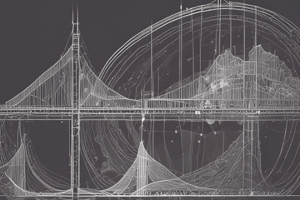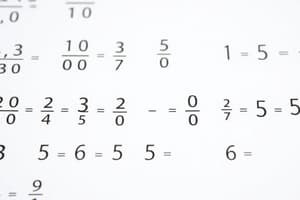Podcast
Questions and Answers
Which statement correctly defines absolute value?
Which statement correctly defines absolute value?
- The distance from zero regardless of direction. (correct)
- The sum of a number and its opposite.
- The numerical value of a number without its sign.
- The distance from a number to another number on the number line.
What is the result of adding ( -7 ) and ( 2 )?
What is the result of adding ( -7 ) and ( 2 )?
- 5
- -9
- -4 (correct)
- -5
What happens when you multiply two negative integers?
What happens when you multiply two negative integers?
- The result is zero.
- The result is undefined.
- The result is positive. (correct)
- The result is negative.
Which of the following is an integer?
Which of the following is an integer?
What is the result of ( -12 \div -3 )?
What is the result of ( -12 \div -3 )?
Which method can be used to add ( \frac{1}{2} ) and ( \frac{2}{3} )?
Which method can be used to add ( \frac{1}{2} ) and ( \frac{2}{3} )?
What is a key characteristic of rational numbers?
What is a key characteristic of rational numbers?
When given the equation ( \frac{x}{3} = 2 ), what is the value of x?
When given the equation ( \frac{x}{3} = 2 ), what is the value of x?
What is a primary reason for using decimal numbers instead of fractions in calculations?
What is a primary reason for using decimal numbers instead of fractions in calculations?
When converting the decimal number 0.6 into a fraction, what is the correct fraction form?
When converting the decimal number 0.6 into a fraction, what is the correct fraction form?
To accurately plot 0.75 on a number line, between which two numbers should it be placed?
To accurately plot 0.75 on a number line, between which two numbers should it be placed?
What is the first step in converting a decimal into a fraction?
What is the first step in converting a decimal into a fraction?
Which of the following statements about comparing decimals is true?
Which of the following statements about comparing decimals is true?
If you have the decimals 0.56 and 0.54, which decimal is greater?
If you have the decimals 0.56 and 0.54, which decimal is greater?
What should be done to the decimal points when adding or subtracting decimal numbers?
What should be done to the decimal points when adding or subtracting decimal numbers?
How do you reverse the process of converting a fraction to a decimal?
How do you reverse the process of converting a fraction to a decimal?
What is the result of rounding 4.276 to the nearest tenth?
What is the result of rounding 4.276 to the nearest tenth?
When solving the equation (x + 3.5 = 8.2), what is the value of (x)?
When solving the equation (x + 3.5 = 8.2), what is the value of (x)?
Which of the following describes how to handle division of decimal numbers?
Which of the following describes how to handle division of decimal numbers?
What is 0.6 times 0.4?
What is 0.6 times 0.4?
What is the correct method to compare two decimal numbers?
What is the correct method to compare two decimal numbers?
What is the result of (2.5 - 1.75)?
What is the result of (2.5 - 1.75)?
If (x < 2.5) and you want to express the same in terms of addition, which inequality is correct?
If (x < 2.5) and you want to express the same in terms of addition, which inequality is correct?
What is 0.375 converted into a fraction?
What is 0.375 converted into a fraction?
Flashcards
Decimal Alignment
Decimal Alignment
Adding zeros to the shorter number to make both numbers have the same number of decimal places before performing addition or subtraction.
Solving Decimal Equations
Solving Decimal Equations
Solving for an unknown variable (x) in an equation that includes decimal numbers.
Decimal Inequalities
Decimal Inequalities
Comparing decimal numbers using inequality signs (>, <, ≤, ≥) while following the same rules as equations.
Decimal Multiplication
Decimal Multiplication
Signup and view all the flashcards
Decimal Division
Decimal Division
Signup and view all the flashcards
Rounding Decimals
Rounding Decimals
Signup and view all the flashcards
Fractions and Decimals
Fractions and Decimals
Signup and view all the flashcards
Integer Numbers
Integer Numbers
Signup and view all the flashcards
Integers
Integers
Signup and view all the flashcards
Opposite Numbers
Opposite Numbers
Signup and view all the flashcards
Absolute Value
Absolute Value
Signup and view all the flashcards
Addition of Integers
Addition of Integers
Signup and view all the flashcards
Multiplication of Integers
Multiplication of Integers
Signup and view all the flashcards
Rational Numbers
Rational Numbers
Signup and view all the flashcards
Decimal Notation of Rational Numbers
Decimal Notation of Rational Numbers
Signup and view all the flashcards
Addition/Subtraction of Rational Numbers
Addition/Subtraction of Rational Numbers
Signup and view all the flashcards
Decimal Number
Decimal Number
Signup and view all the flashcards
Fraction to Decimal
Fraction to Decimal
Signup and view all the flashcards
Decimal on Number Line
Decimal on Number Line
Signup and view all the flashcards
Comparing Decimals
Comparing Decimals
Signup and view all the flashcards
Adding/Subtracting Decimals
Adding/Subtracting Decimals
Signup and view all the flashcards
Multiplying Decimals
Multiplying Decimals
Signup and view all the flashcards
Dividing Decimals
Dividing Decimals
Signup and view all the flashcards
Importance of Decimals
Importance of Decimals
Signup and view all the flashcards
Study Notes
7th Grade Math Notes
- Decimal numbers are a way of writing fractions using powers of 10.
- Decimals are useful in daily life for things like money, measurements, and scientific data.
- Decimals are easier to work with than fractions in calculations and comparisons.
- Converting decimals to fractions involves writing the decimal as a fraction with a denominator of 10, 100, or 1000, etc., depending on the number of decimal places. Then simplify the fraction by dividing both the numerator and denominator by their greatest common divisor (GCD).
- Conversely, converting fractions to decimals involves dividing the numerator by the denominator.
- Plotting decimal numbers on a number line involves breaking the number line into equal parts based on the decimal's place value.
- Comparing decimals involves comparing the digits from left to right, and adding zeros to the right of the decimal if necessary to ensure like place values.
- Decimal addition and subtraction involves lining up decimal points and adding or subtracting as needed.
- Rules for multiplication of decimals include ignoring the decimal point, multiplying as whole numbers, and then placing the decimal point based on the total number of decimal places in the factors.
- Decimal division involves multiplying both the divisor and dividend by a power of 10 to make the divisor a whole number, and then dividing as usual.
- Rounding decimal numbers involves looking at the digit to the right of the rounding place. If the digit is 5 or greater, round up. Otherwise, round down.
- Converting between fractions and decimals is useful when using fractions in calculations that require decimals.
- There are various real-life applications for decimals like working in engineering, finance, science, everyday problem-solving, buying, selling or budgeting money.
Integer Numbers
- Integers include positive numbers, negative numbers, and zero.
- They can be represented as points on a number line.
- Opposite numbers are integers that have the same absolute value but are of the opposite sign.
- The absolute value of a number is its distance from zero, and is always positive.
- Addition of integers with the same signs requires adding the numbers and retaining the same sign.
- Addition of integers with different signs involves subtracting the numbers and taking the sign of the larger number.
- Subtraction with integers involves treating the subtraction as the adding of the negative of the second number.
- Multiplication of integers with the same signs results in a positive integer.
- Multiplication of integers with different signs results in a negative integer.
- Division of integers with the same signs results in a positive integer.
- Division of integers with different signs results in a negative integer.
Rational Numbers
- Rational numbers are numbers that can be expressed as a fraction (p/q), where p and q are integers and q is not zero.
- Rational numbers can be represented on the number line.
- Rational numbers can be expressed as either ending or repeating decimals.
- Rational numbers can be positive or negative.
- Rational numbers can be added, subtracted, multiplied and divided.
- Rational numbers can be used to solve equations and inequalities.
- Rational numbers are useful to model or interpret real-world situations like distances, money or quantities.
Studying That Suits You
Use AI to generate personalized quizzes and flashcards to suit your learning preferences.




